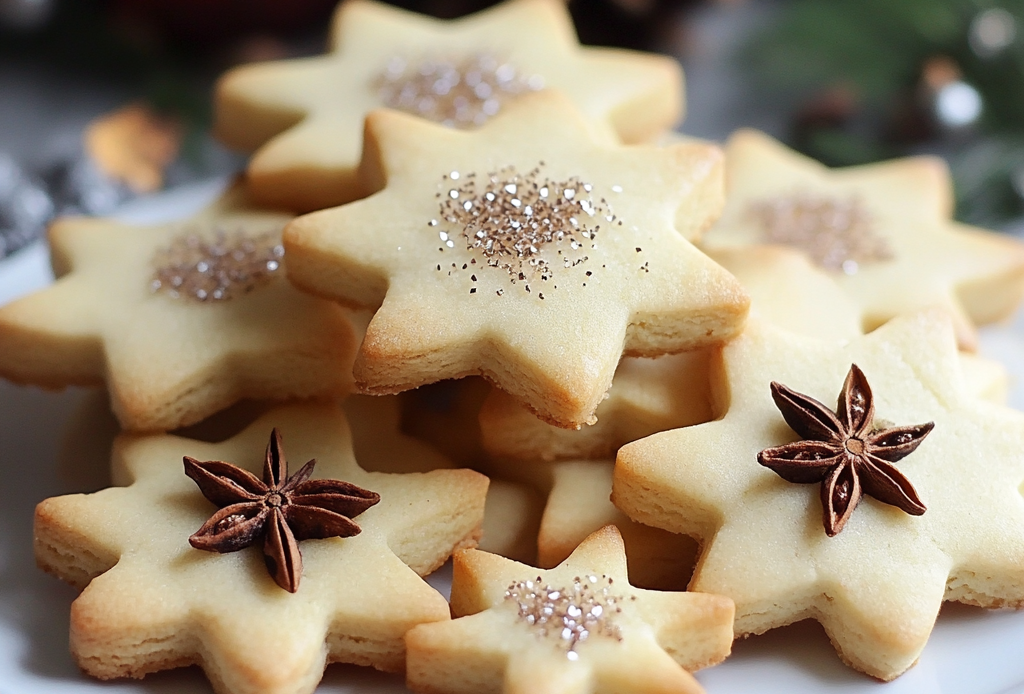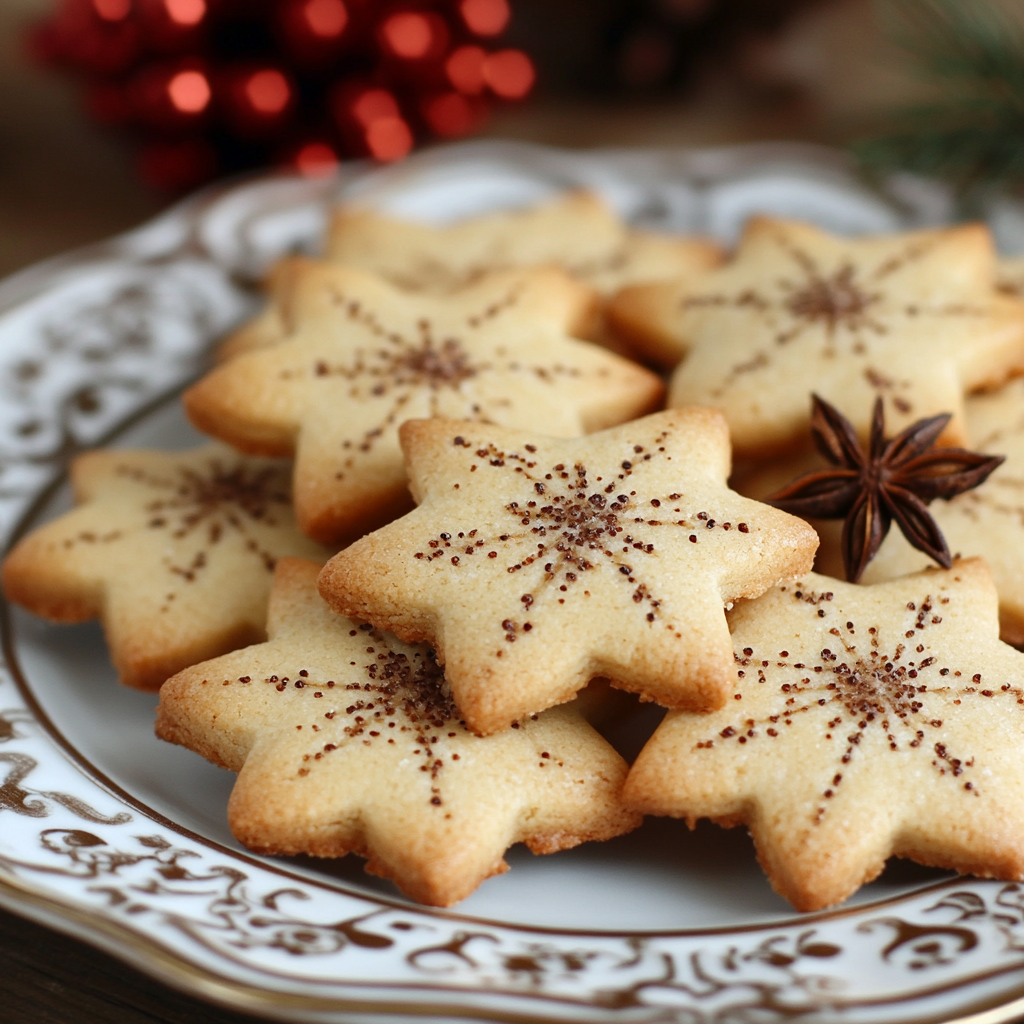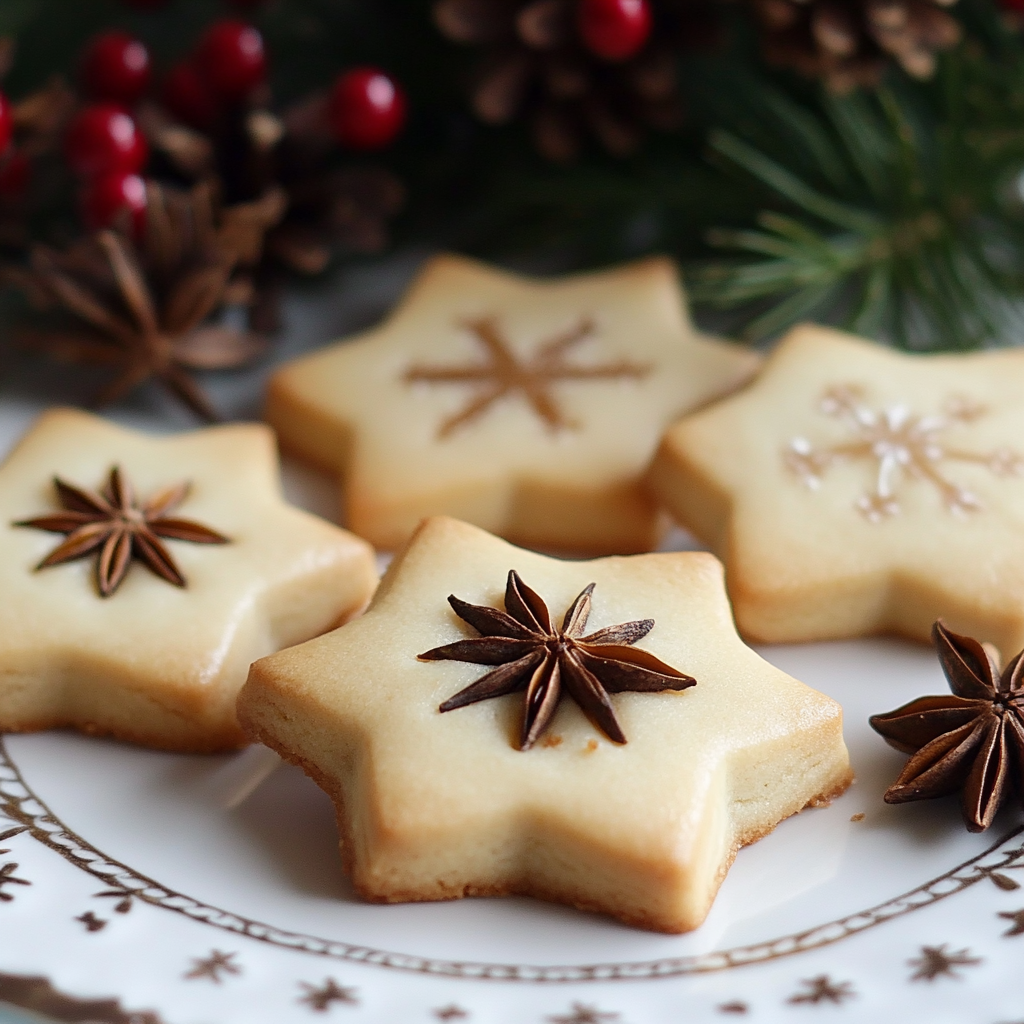
The first time I baked anise cookies, the kitchen was filled with a scent that felt like a hug from my grandmother’s childhood in Italy. Those small, crisp rounds weren’t just treats—they were a bridge to her stories of village markets and winter festivals. Now, I want to share that same warmth with you. This guide reveals how to craft anisette cookie recipe perfection, blending heritage with hands-on advice.
Key Takeaways
- Learn the cultural journey of anise cookies from European roots to American holiday tables.
- Master the anisette cookie recipe with precise ingredient ratios and texture secrets.
- Discover essential tools like engraved molds and cooling techniques for crisp results.
- Explore global variations like German Springerle and modern glazing ideas.
- Follow storage tips to keep anise cookies fresh for gifting or seasonal celebrations.

What Are Anise Cookies and Their Cultural Heritage
Anise cookies are a beloved treat known for their strong licorice flavor. This flavor comes from anise extract or oil. They are a key part of holiday traditions and cultural celebrations in Europe and the U.S.
The Distinct Licorice-Like Flavor Profile
Anise cookies have a unique taste that’s not too sweet. They mix herbal and peppery notes. This flavor comes from anise seeds or extracts, making them special in European baking.
- Anise oil for intense licorice essence
- Subtle warmth from spice blends
- Contrast to vanilla or chocolate-dominant cookies
European Origins and American Adaptations
Anise cookies german like Springerle come from 16th-century Germany. When immigrants came to America, they kept their traditions alive with local ingredients. Here’s how they adapted:
| Origin | Traditional Recipe | American Adaptation |
|---|---|---|
| Germany | Springerle with carved molds | Flour and sugar adjustments |
| Italy | Pizzelle with anise | Winter spice blends |
| Scandinavia | Pepparkakor with anise | Modern toppings like chocolate |
Holiday Traditions Associated with Anise Cookies
These cookies are a big part of festive celebrations. In Germany, anise cookies german like Springerle are exchanged at Christmas. In the U.S., they’re in holiday gift baskets. Here are some traditions:
- German Springerle at Christmas markets
- Italian anise pizzelle at Easter
- American holiday markets selling shaped anise cookies
The History Behind Traditional Anise Cookies
Anise cookies have a long history, starting in ancient Rome. People valued anise seeds for their flavor and health benefits. They were used in breads and sweets to aid digestion.
As time went on, these spices found their way into cookie recipes. This mix of tradition and practicality created the anise cookies we know today.
By the medieval times, anise cookies were common in European kitchens. In Germany, Italy, and Spain, they were a sign of celebration and health. Their unique taste made them a hit at festivals.
They were also seen as a health remedy, kept in homes for their medicinal properties. Each region had its own special way of making them:
- Germany: Springerle, a carved-animal-shaped cookie, emerged as a hallmark of anise cookies german craftsmanship.
- Italy: Anise-infused biscotti paired with espresso.
- Spain: Small anise-flavored pastries marked religious holidays.
Immigrants brought these recipes to America in the 19th century. German settlers in the Midwest and Pennsylvania Dutch communities kept anise cookies alive as holiday treats. These recipes adapted to local ingredients but kept their cultural roots.
Early 20th-century cookbooks like The Fannie Farmer Cookbook included anise-flavored recipes. This solidified their place in American baking traditions.
Today, anise cookies german like Springerle are cherished symbols of heritage. They are often exchanged during Christmas. Their journey from ancient Rome to modern kitchens is a testament to how food connects us across time and space.
Essential Ingredients for Perfect Anise Cookies
Creating the perfect anise cookie recipe begins with picking the right ingredients. Each part is crucial for texture, taste, and smell. Here’s how to pick the best ingredients for a homemade anisette cookie recipe.
Flour, Sugar, and Butter Requirements
- Flour: All-purpose flour gives structure, while cake flour makes the cookies softer. Replace ¼ cup of all-purpose flour with cake flour to keep them delicate.
- Sugar: Mix granulated sugar for crisp edges and powdered sugar for moisture. Use a 2:1 ratio for sweetness without grit.
- Butter: Choose unsalted butter for better flavor control. Let it warm to 65°F (18°C) for flaky layers.
Anise Extract vs. Anise Oil: Which to Choose
Anise extract gives a mild licorice taste, while anise oil is stronger. Use ½ teaspoon extract or ¼ teaspoon oil per batch. A chef’s tip: Mix 1 drop oil with 1 tsp extract for deeper flavor.
Optional Ingredients for Enhanced Flavor
Add these to enhance your cookies:
- Citrus zest (lemon or orange) for a bright taste
- Almond extract (¼ tsp) for a German Springerle taste
- Anisette liqueur (1 tbsp) for extra moisture and flavor
Start with small amounts to keep the anise flavor in the spotlight.
Kitchen Equipment You’ll Need
Mastering the anisette cookie recipe begins with the right tools. The right equipment ensures your anise cookies are perfectly shaped and baked. Here’s what you need in your baking arsenal.
Mixing and Measuring Tools
Accurate measurements are key to avoid lumpy dough or uneven baking. You’ll need:
- Stainless steel measuring cups (OXO Good Grips)
- Metal measuring spoons
- Stand mixer (KitchenAid) or hand mixer for creaming butter and anise extract
- Silicone spatula for scraping bowls
Baking Sheets and Prep Surfaces
Choose light-colored, heavy-gauge aluminum baking sheets to prevent burning. Also, consider:
- Parchment paper or silicone baking mats (Silpat)
- Plastic dough scrapers for shaping
“A clean work surface with flour helps roll dough without sticking,” say professional bakers.
Specialized Equipment for Shaped Cookies
For classic designs, use these tools:
| Tool | Use | Top Brands |
|---|---|---|
| Cookie press | For delicate patterns in anise dough | Wilton, Ateco |
| Springerle mold | Imprints traditional German designs | Lehman’s, The Cookie Store |
| Decorative cutters | Shapes like stars or leaves | USA Pan, Nordic Ware |
No specialty items? A fork can score dough or roll into balls for simpler anise cookies. Being adaptable makes tradition accessible for all.
Step-by-Step Anise Cookies Recipe
Making anise cookies needs careful steps. Follow this guide for a crisp cookie and true flavor:
| Ingredient | US Standard | Metric |
|---|---|---|
| Unsalted Butter | ½ cup | 113g |
| Granulated Sugar | ¾ cup | 150g |
| Eggs | 1 large | 50g |
| All-Purpose Flour | 2 cups | 250g |
| Anise Extract | 1 tbsp | 15ml |
- Preheat oven to 350°F (175°C). Line baking sheets with parchment paper.
- Cream butter and sugar in a mixer on medium speed until light and fluffy (~3 minutes).
- Add eggs and anise extract, mixing until fully incorporated.
- Gradually mix in flour until dough forms. Chill for 30 minutes.
- Roll dough into 1-inch balls. Place 2 inches apart on baking sheets.
- Flatten each ball with a fork to create a crosshatch pattern.
- Bake 12–15 minutes until edges are golden. Cool on racks.
- For softer cookies, reduce baking time by 2 minutes.
- Double the recipe for large batches; keep dough chilled until ready to roll.
- Freeze unbaked dough balls for up to 1 month.
Getting perfect anise cookies comes from careful temperature and dough handling. Adjust how you shape them to your liking, but stick to these steps.
The Secret to Achieving the Perfect Texture
Getting the right texture in anise cookies is all about three steps. These steps work for both classic anise cookies and anisette cookie recipes. They make sure every batch is perfect.
Finding the Ideal Dough Consistency
Start by checking the dough’s texture. It should stick together when pinched but not to your hands. If it’s too dry, add a bit of milk. If it’s too soft, add a little flour.
Don’t overmix the dough. It can make the cookies tough. Stop mixing when everything is just combined. Chilling the dough for 15–20 minutes helps it firm up before rolling.
Baking Temperature and Timing Considerations
Preheat your oven to 350°F (175°C). Place the rack in the center. The success of anisette cookies depends on this step.
Check the cookies at 10 minutes. They should look set but still pale. If they’re underbaked, they’ll stay soft. If overbaked, they’ll crack.
Use an oven thermometer to check the temperature. Many ovens are not accurate.
Cooling Methods for Optimal Results
Let cookies cool on the baking sheet for 2 minutes. Then, move them to a rack. This helps them firm up without getting soggy.
To keep anise cookies crisp, don’t stack them while they cool. In humid places, bake them for 5–10 seconds longer. This helps prevent moisture.
Use mesh racks for cooling. They let air flow, preventing heat from getting trapped.
Traditional German Anise Cookies Variation
German anise cookies are a big part of their traditions. Springerle, a treat from Bavaria and Swabia, is a great example. These cookies are special because they dry for 12-24 hours before baking. This makes them crisp and gives them a unique anise taste.
Springerle: The Classic German Anise Cookie
Springerle dough is made with anise seed powder, sugar, and eggs. After shaping, the cookies sit overnight to get hard. This helps keep the designs from molds, like religious scenes or family crests, sharp.
Experts say to use twice as much sugar as flour for the best results.
Special Molds and Impressions in German Tradition
Old Springerle molds were carved from lime wood and passed down through families. Today, bakers use silicone molds for easier cleaning. It’s important to oil wooden molds with shortening to keep them in good shape.
| Type | Material | Design Themes |
|---|---|---|
| Antique | Lime wood | Religious symbols, family crests |
| Modern | Silicone | Floral patterns, geometric shapes |
Regional German Variations to Try
- Anisplätzchen: Northern Germany’s soft anise cut-outs dusted with powdered sugar.
- Anisbögen: Crescent-shaped cookies from Hesse, rolled in anise seeds.
- Frankfurter Kranz: Ring-shaped treats from Frankfurt, infused with both anise and orange zest.
Each type of cookie shows off local tastes but keeps the anise flavor. Bakers can try these by changing the dough’s texture and flavor.
Decorating and Glazing Your Anise Cookies
Turn simple anise cookies into stunning treats with glazing. Begin with a basic powdered sugar glaze. Mix 1 cup powdered sugar with 1–2 teaspoons lemon juice or milk until it’s smooth. For a shiny finish, add a pinch of meringue powder. Adjust the glaze’s thickness to suit your decorating needs.
- Powdered sugar glaze: Perfect for a classic look on traditional anise cookies
- Royal icing: Great for detailed designs like flowers or patterns
- Flavored variations: Add citrus zest or almond extract to enhance the anisette cookie recipe’s taste
Enhance your cookies with toppings like rainbow nonpareils, sliced almonds, or colored sugar sprinkled right after glazing. For striking borders, use tinted icing and food-safe dyes. Try a lemon glaze for a refreshing twist that complements the anise flavor.
Decorate only when cookies are cool to avoid melting. A light orange glaze is lovely with the licorice notes in the anisette cookie recipe. Let the glazed cookies dry on a wire rack for 1–2 hours before stacking. Play with seasonal colors like red and green for holidays or pastels for spring, while keeping the design simple.
Storage Tips to Maintain Freshness and Flavor
Keeping anise cookies fresh and fragrant is key. Follow these tips to keep their licorice taste and texture. They work for both short-term and long-term storage.
Short-Term Storage Solutions
For crisp cookies, use airtight containers. For softer ones, choose slightly ventilated options. Metal tins are great for keeping moisture away.
Plastic containers with breathable lids are better for softer cookies. Store decorated cookies separately to avoid moisture and flavor mixing. Keep them away from heat sources like ovens or windows.
Freezing Instructions for Long-Term Preservation
- Cool baked anise cookies completely before freezing.
- Wrap each layer with parchment paper to prevent sticking.
- Freeze for up to 3 months. For dough, shape into balls, freeze, then bake later.
Reviving Stale Anise Cookies
- Crisp revival: Preheat oven to 300°F (150°C). Bake cookies 5-7 minutes.
- Moisture restoration: Add a slice of apple or bread to the container overnight.
“Always let frozen cookies thaw at room temperature for 2-3 hours before serving,” says Master Baker Clara Müller of Berlin’s historic bakery, Konditorei Lübeck.

Glazed or decorated cookies need separate storage in open containers. This way, their frosting won’t get damaged. These tips help keep your homemade anisette cookies fresh for weeks or months.
Common Troubleshooting for Anise Cookie Baking
Mastering the anise cookies process can sometimes present challenges. Here’s how to fix common issues:
| Problem | Cause | Solution | Preventative Tip |
|---|---|---|---|
| Crumbly dough | Too much flour or cold butter | Add 1 tsp egg yolk or warm butter slightly | Measure flour by spooning and leveling |
| Overly spread cookies | Room-temperature dough or excess leavening | Chill dough 15 mins before baking | Refrigerate dough 1 hour before shaping |
| Faint anise flavor | Expired spices or insufficient extract | Use fresh anise extract (½ tsp per 2 cups flour) | Test extract potency by smell |
For anisette cookie recipe texture flaws like rock-hard results, check oven temperature accuracy. Use an oven thermometer to ensure the bake zone is 325–350°F. If glaze cracks while decorating, reduce icing thickness by adding ¼ tsp water. Professional bakers recommend storing unused dough in airtight containers to prevent drying. Always test a single cookie first when adjusting recipes to avoid waste.
Serving Suggestions and Perfect Pairings
Anise cookies and their German cousins, anise cookies german, are best when paired well. They come alive when matched with drinks and displays that complement their licorice flavor.
“Pairing anise cookies with coffee or tea is like harmonizing a melody,” says Munich-based baker Anna Müller. “The right beverage lifts their subtle sweetness.”
Beverage Pairings:
- Hot: Espresso, black tea, or spiced chai enhance the anise flavor.
- Cold: Pair with sparkling lemonade or apple cider for a refreshing contrast.
- Alcoholic: Try anisette liqueur or port wine for an adult twist.
Gift Basket Ideas:
| Theme | Cookies | Additions | Packaging |
|---|---|---|---|
| German Tradition | Springerle, gingerbread | Spiced nuts, dark chocolate | Wooden crate with red ribbon |
| Winter Festive | Anise cookies, peppermint | Candied oranges, cinnamon sticks | Clear gift box with holly accents |
Holiday displays can highlight cultural roots. For German-inspired spreads, arrange cookies on a slate board with marzipan sculptures. At Christmas gatherings, layer cookies on tiered stands with fruit compote. For simplicity, serve in mini mason jars with recipe cards.
Whether enjoyed with a sip of espresso or gifted in themed baskets, anise cookies german and their variations become centerpieces of celebration. Thoughtful pairings transform a snack into a sensory experience.
Conclusion: Embracing the Timeless Tradition of Anise Cookies
Anise cookies are more than just treats; they hold stories of heritage and connection. They connect generations with their unique licorice flavor and designs. German Springerle, for example, show how these cookies have shaped baking traditions.
These recipes are easy to adapt to today’s tastes, using anise extract or glazes. Baking them is a way to slow down and enjoy the moment. Sharing them with family and friends keeps a tradition of hospitality alive.
Think of these cookies as a bridge between cultures and family memories. Try using Springerle molds, pair them with coffee or spiced tea, or package them in homemade gift boxes. Your kitchen becomes part of a global story. Share your baking journey online or at gatherings—every batch adds a new chapter to this sweet tradition. Let the aroma of anise remind us that some flavors, like history, deserve to be passed forward.
FAQ
What are anise cookies?
Anise cookies are sweet treats with a licorice-like flavor. They come from anise seeds, extract, or oil. People enjoy them in many cultures, especially during holidays.
How do I make traditional German anise cookies?
To make traditional German anise cookies, like Springerle, you need flour, sugar, butter, and anise flavoring. You also need to use molded designs. Look for authentic recipes online or in German baking cookbooks.
Can I substitute anise extract with anise oil in my cookie recipe?
Yes, you can use anise oil instead of extract. But remember, it’s stronger. Start with half the amount called for and adjust to taste.
What other flavors pair well with anise cookies?
Anise cookies can be even better with citrus zest, vanilla, or a bit of anisette liqueur. These add to their unique taste.
How should I store freshly baked anise cookies?
Keep anise cookies in an airtight container to stay fresh. For crisp cookies, let the container breathe a bit. For softer cookies, seal it tight. Don’t mix different cookies to avoid flavor mixing.
What is the best way to revive stale anise cookies?
To make stale anise cookies crisp again, bake them at a low temperature. Or, place a slice of apple or bread with them for a few hours to add moisture.
What is the difference between anise cookies and other flavored cookies?
Anise cookies are special because of their licorice flavor. This comes from anise seeds, extract, or oil. It makes them different from other cookies.
Are there variations of anise cookies I can try?
Yes, you can try Italian anisette cookies or German Springerle for different tastes and textures. Each culture has its own way of making anise cookies, using local ingredients and methods.
What baking equipment do I need to make anise cookies?
You’ll need mixing bowls, measuring cups and spoons, baking sheets, and parchment paper. You might also use cookie cutters or molds. A stand mixer helps mix the dough well.
What are springerle cookies, and how are they related to anise cookies?
Springerle are German anise cookies known for their detailed designs from molds. They’re firm and flavored with anise. They’re a special type of anise cookie.




